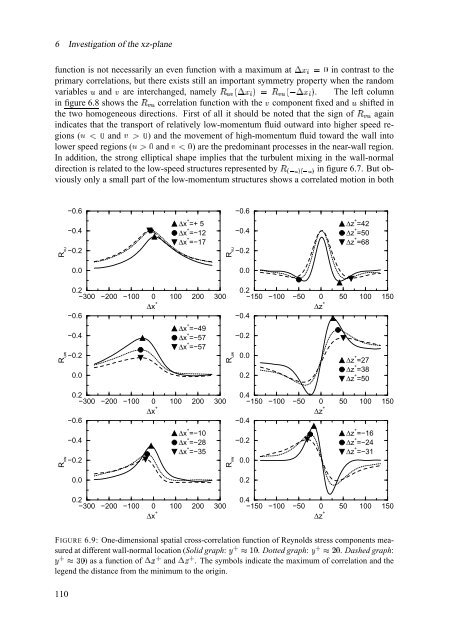The significance of coherent flow structures for the turbulent mixing ...
The significance of coherent flow structures for the turbulent mixing ...
The significance of coherent flow structures for the turbulent mixing ...
Create successful ePaper yourself
Turn your PDF publications into a flip-book with our unique Google optimized e-Paper software.
è<br />
è<br />
ã<br />
ã<br />
ã<br />
æ<br />
æ<br />
æ<br />
æ<br />
æ<br />
æ<br />
è<br />
è<br />
æ<br />
æ<br />
æ<br />
æ<br />
æ<br />
æ<br />
ã<br />
ã<br />
ã<br />
6 Investigation <strong>of</strong> <strong>the</strong> xz-plane<br />
function is not necessarily an even function with a Í5Î ¿ À maximum at in contrast to <strong>the</strong><br />
primary correlations, but <strong>the</strong>re exists still an important symmetry property when <strong>the</strong> random<br />
variables and are interchanged, namely Ã Ñ Ë ¹ Í5Î|¼ ¿ ÃË Ñ ¹ Í5Î|¼ . <strong>The</strong> left column<br />
§<br />
in figure 6.8 shows · Ñ <strong>the</strong> correlation function with <strong>the</strong> component fixed and § shifted in<br />
ÃË<br />
<strong>the</strong> two homogeneous directions. First <strong>of</strong> all it should be noted that <strong>the</strong> sign · Ñ <strong>of</strong> ÃË again<br />
indicates that <strong>the</strong> transport <strong>of</strong> relatively low-momentum fluid outward into higher speed re-<br />
) and <strong>the</strong> movement <strong>of</strong> high-momentum fluid toward <strong>the</strong> wall into<br />
½þÀ<br />
(§ßºöÀ gions and<br />
lower speed regions ·<br />
and · º¤À ) are <strong>the</strong> predominant processes in <strong>the</strong> near-wall region.<br />
(§N½¤À<br />
In addition, <strong>the</strong> strong elliptical shape implies that <strong>the</strong> <strong>turbulent</strong> <strong>mixing</strong> in <strong>the</strong> wall-normal<br />
direction is related to <strong>the</strong> low-speed <strong>structures</strong> represented à êJî Ñí êJî Ñí by in figure 6.7. But obviously<br />
only a small part <strong>of</strong> <strong>the</strong> low-momentum <strong>structures</strong> shows a correlated motion in both<br />
−0.6<br />
−0.6<br />
R vu<br />
−0.4<br />
−0.2<br />
æ<br />
∆x + =+ 5<br />
∆x + =−12<br />
∆x + =−17<br />
R vu<br />
−0.4<br />
−0.2<br />
æ<br />
∆z + =42<br />
∆z + =50<br />
∆z + =68<br />
0.0<br />
0.0<br />
R uw<br />
ã 0.2<br />
−300 −200 −100 0 100<br />
∆x +<br />
−0.6<br />
−0.4<br />
−0.2<br />
0.0<br />
200<br />
ã<br />
æ<br />
∆x + =−49<br />
∆x + =−57<br />
∆x + =−57<br />
300<br />
ã<br />
R uw<br />
â 0.2<br />
−150 −100 −50 0 50 100<br />
∆z +<br />
−0.4<br />
−0.2<br />
0.0<br />
0.2<br />
æ<br />
∆z + =27<br />
∆z + =38<br />
∆z + =50<br />
150 â<br />
R vw<br />
ã 0.2<br />
−300 −200 −100 0 100<br />
∆x +<br />
−0.6<br />
−0.4<br />
−0.2<br />
200<br />
ã<br />
æ<br />
∆x + =−10<br />
∆x + =−28<br />
∆x + =−35<br />
300<br />
ã<br />
R vw<br />
â 0.4<br />
−150 −100 −50 0 50 100<br />
∆z +<br />
−0.4<br />
−0.2<br />
0.0<br />
æ<br />
∆z + =−16<br />
∆z + =−24<br />
∆z + =−31<br />
150 â<br />
0.0<br />
0.2<br />
ã<br />
0.2<br />
−300 −200 −100 0 100<br />
∆x<br />
200<br />
ã<br />
300<br />
ã<br />
â 0.4<br />
−150 −100 −50 0 50 100<br />
∆z<br />
150 â<br />
FIGURE 6.9: One-dimensional spatial cross-correlation function <strong>of</strong> Reynolds stress components measured<br />
at different wall-normal location (Solid graph: Ó ® Ô Ü Ø<br />
. Dotted graph: Ó ® Ô×Ú¥Ø<br />
. Dashed graph:<br />
Ó ®NÔõÖ¥Ø<br />
) as a function <strong>of</strong> ®<br />
and ®<br />
. <strong>The</strong> symbols indicate <strong>the</strong> maximum <strong>of</strong> correlation and <strong>the</strong><br />
legend <strong>the</strong> distance from <strong>the</strong> minimum to <strong>the</strong> origin.<br />
110
















